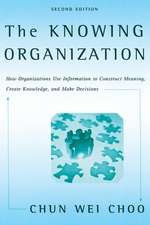Large-Scale Organizational Change
Autor Christopher Laszlo, Jean Francois Laugelen Limba Engleză Paperback – 20 oct 1999
The context for large scale organizations is one of information overload, complexity and constant change. This book reduces the sense of vulnerability felt by managers. It provides a guide to piloting change in ways that lead to constant renewal and a capacity to survive frequent and often brutal changes in the operating environment. It describes a leadership concerned with the capacity to learn, inflection points, emergent strategies, knowledge management, the ability to anticipate, and tapping into the distributed intelligence resident in the organization.
Large Scale Organizational Change provides managers with a framework for making their organizations highly adaptive in the complex market systems in which they operate, thereby reducing or eliminating the need for periodic episodes of traumatic restructuring and sometimes fatal reengineering processes.
Preț: 222.75 lei
Preț vechi: 357.04 lei
-38% Nou
Puncte Express: 334
Preț estimativ în valută:
42.62€ • 44.51$ • 35.20£
42.62€ • 44.51$ • 35.20£
Carte tipărită la comandă
Livrare economică 08-22 aprilie
Preluare comenzi: 021 569.72.76
Specificații
ISBN-13: 9780750672306
ISBN-10: 0750672307
Pagini: 264
Dimensiuni: 156 x 234 x 13 mm
Greutate: 0.49 kg
Ediția:1
Editura: Taylor & Francis
Colecția Routledge
Locul publicării:Oxford, United Kingdom
ISBN-10: 0750672307
Pagini: 264
Dimensiuni: 156 x 234 x 13 mm
Greutate: 0.49 kg
Ediția:1
Editura: Taylor & Francis
Colecția Routledge
Locul publicării:Oxford, United Kingdom
Public țintă
Professional Practice & DevelopmentCuprins
A New Wisdom; Part 1 Oracle and Lafarge: Perpetual Transformation in Action; Part 2 Chaos Dynamics: Lessons from the New Sciences; Part 3 The Ten Principles; Part 4 Principle I. Create Adaptive Strategies; Part 5 Principle II. Maintain Long-term Identity while Repositioning; Part 6 Principle III. Compete for Industry Sustainability; Part 7 Principle IV. Use Strategic Inflection Points; Part 8 Principle V. Link Transformation to Shareholder Value Creation; Part 9 Principle VI. Develop Ambitions Greater than Means; Part 10 Principle VII. Design Decision-making Systems for Self-organization; Part 11 Principle VIII. Fluidify the Organizational Structure; Part 12 Principle IX. Use Organizational Instability to Catalyze Learning; Part 13 Principle X. Reenvision Leading: From Command and Control to (r)evolutionary Influence; Part 14 Managing Information: A Key to Successfu1 Implementation; Part 15 Managing Information: A Key to Successfu1 Implementation; Part 16 Conclusion;
Descriere
Large Scale Organizational Change provides the principles by which large scale organizations reinvent themselves not once, but on an ongoing basis. Continual reinvention allows leading companies to learn, adapt, and innovate faster than competitors in complex and fast changing environments. These action principles are based on first-hand experience at the world's leading Fortune 500 companies using emergent models of living systems.
The context for large scale organizations is one of information overload, complexity and constant change. This book reduces the sense of vulnerability felt by managers. It provides a guide to piloting change in ways that lead to constant renewal and a capacity to survive frequent and often brutal changes in the operating environment. It describes a leadership concerned with the capacity to learn, inflection points, emergent strategies, knowledge management, the ability to anticipate, and tapping into the distributed intelligence resident in the organization.
Large Scale Organizational Change provides managers with a framework for making their organizations highly adaptive in the complex market systems in which they operate, thereby reducing or eliminating the need for periodic episodes of traumatic restructuring and sometimes fatal reengineering processes.
The context for large scale organizations is one of information overload, complexity and constant change. This book reduces the sense of vulnerability felt by managers. It provides a guide to piloting change in ways that lead to constant renewal and a capacity to survive frequent and often brutal changes in the operating environment. It describes a leadership concerned with the capacity to learn, inflection points, emergent strategies, knowledge management, the ability to anticipate, and tapping into the distributed intelligence resident in the organization.
Large Scale Organizational Change provides managers with a framework for making their organizations highly adaptive in the complex market systems in which they operate, thereby reducing or eliminating the need for periodic episodes of traumatic restructuring and sometimes fatal reengineering processes.
















